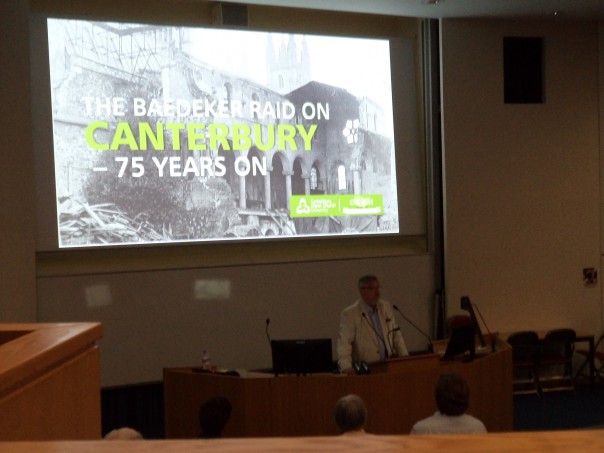Just a couple of points before I turn to the focus of the blog this week: Dr Martin Watt’s Baedeker Raid on Canterbury half-day conference and afternoon guided walk last Saturday. Firstly ‘Tithe through the Ages: the Historian’s View’ is coming up fast on Saturday 17 June: details at www.canterbury.ac.uk/tithe and secondly, the Centre has a major advert at the beginning of the current issue of History Today offering information on future events.
After refreshments and an opportunity to look at the display of photographs on the aftermath of the raids on Canterbury, provided by Cressida Williams at Canterbury Cathedral Archives and Library, the almost a hundred strong audience filed into the Michael Berry Lecture Theatre. Martin began the proceedings by welcoming everyone to this conference and reminding them that what we were collectively remembering today was a very important event in Canterbury’s long history, and one that some of the audience had actually lived through. So yes, it is the subject of academic study, but equally it is very much a human story and he hoped the conference would reflect both aspects. It is also worth noting at this stage that any surplus after expenses have been covered will be used to boost the Ian Coulson Memorial Postgraduate Award fund, which is and will continue to help students to study a wide range of Kent history topics including Canterbury and Kent’s WWII experiences.
The first speaker was Kevin Ruane, Professor of Modern History at Canterbury Christ Church, who provided a national and international context for the Baedeker raids on Canterbury in 1942. He began by outlining the early history of aerial attacks on those on the ground using projectiles, the first of which took place in 1911 when an Italian pilot Giulio Gavotti dropped four grenades one by one on a Turkish encampment in Libya during the war between the two countries. Although there were no casualties on this occasion, the potential was immediately realised and the First World War witnessed bombing raids by both Zeppelins and planes, the first of these in August 1914 on the Belgium city of Liege when nine civilians were killed. However, Kevin believes it was the deaths of 18 children, due to a Zeppelin raid on 8 September 1915 at Upper North Fleet School in Poplar, that really brought home to people just what destruction and loss of life could come from the skies. It was said that 100,000 mourners turned out for the funerals of these schoolchildren and now all knew modern war would mean the involvement of civilians rather than being the preserve of the nation’s armed forces.
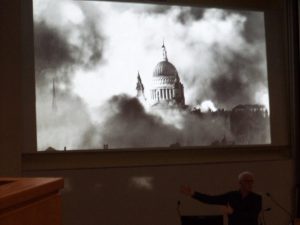
The inter-war years offered further opportunities to develop these aerial techniques in the Spanish Civil War and in other theatres of war such as conflict in the Far East, which meant that by 1939 national capabilities had grown and the potential was in the national consciousness, as in George Orwell’s Coming Up for Air, published in June that year. Consequently bombing of civilians WAS going to be part of WWII. However, as Kevin discussed, Churchill saw little option but to use night bombing against military targets, once he was in a position to order these raids, albeit the accuracy was not high. The German bombers, the Blitz on London and attacks on other centres, including Coventry, also showed what could and couldn’t be achieved using such tactics. Yet it might be said that it was the new strategy, in 1942, of deliberate night-time area bombing of densely packed urban centres that was the next chapter in the move towards total war. In terms of what it might achieve, it was not expected to be decisive, but it was thought to be an effective weakening strategy of the enemy’s morale and capability. The RAF’s raid on Lubeck, a Hanseatic medieval gem, and the subsequent bombing of another Hanseatic city, the port of Rostock, might be said to have brought the expected German response with what became known as the Baedeker raids. Although probably apocryphal, it was said that the German High Command decided to hit historic English towns rated as three stars in the Baedeker guides for its retaliatory bombing raids. Thus in the spring of 1942 German bombers attacked Exeter, Bath, Norwich and York. This tit-for-tat policy continued and the British raid on Cologne was followed by the German raid on Canterbury. Yet, as Kevin said, the daylight raid the same year on 31 October when 30 German Focke-Wulf fighters in a short killing spree created havoc, killing 33 people in parts of Canterbury and Sturry, could have been even worse because Churchill’s wife and the wife of President Roosevelt had been in the city the previous day.
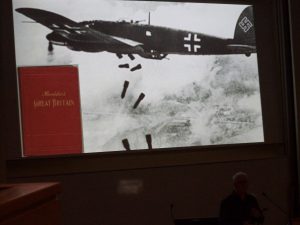
Kevin concluded by discussing the Anglo-American intensification of the bombing of German cities in 1943-45, especially Hamburg and Dresden, and the nuclear bombing of Japan with regard to Churchill’s moral stance on these issues, as well as the positions held by others, including prominent senior churchmen. As he was keen to stress, the leading politicians were well aware of the moral dilemma such total war posed, but there was to a degree a realisation that the options were severely limited if not non-existent at various times during WWII. Kevin was similarly keen to point out that this was a sober topic and that he was treating it with great seriousness, albeit, as he said, historians discussing Churchill’s speeches cannot help but copy him because of his use and command of rhetoric. Consequently, Kevin’s rendition of Churchill’s iconic words added a certain lightness of touch and greatly added to his excellent lecture that did far more than ‘Set the Scene’ for the lectures after the second refreshment break. Because I missed Jordan Newton’s talk – apologies Jordan – Dr Diane Heath has kindly supplied the next two paragraphs.
Jordan began his talk with the iconic shot of St Paul’s in the Blitz – the symbol of resolution in dark times, which you can see Kevin had also shown (see above). It’s a very striking image and Jordan used it to compare the bombing of London with the experiences of Canterbury’s citizens. The Baedeker raid on Canterbury was expected as the night before the British had rained down bombs on Cologne and Lord Haw-Haw had threatened Canterbury with retribution if Cologne suffered. Yet, as Jordan pointed out, Canterbury was not unprepared for bombing raids. Among the actions that had been taken already were the construction of shelters, started in 1935, and the appointing, training and equipping of firewatchers. In addition, householders had been registered, given instructions and a list of simple equipment, and urged to watch demonstrations of how to rescue people from burning buildings, and how to operate stirrup pumps fed from a pail of water. Incidentally, at the end of the conference Tim Jones showed colour film of WW2 Canterbury firewatchers in training.
Furthermore, Jordan emphasised how Canterbury City Council had emergency accommodation well in hand, and he pointed out that the temporary British Restaurant was serving breakfasts the very next day after the first raid, not only for those bombed out but for those whose essential services (water and gas) were disrupted. As a way of emphasising the official position, Jordan showed this Imperial War Museum poster http://www.iwm.org.uk/sites/default/files/styles/article_main/public/iwm_solr_field/large/ART.-IWM-PST-13871_800.jpg?itok=DrwaV2gx×tamp=1479312081 ]
Perhaps catching the spirit of the times, the ‘Red Dean’ of Canterbury Cathedral Dr Hewlett Johnson commented that Canterbury citizens’ kind and cheerful way of coping with this horror brought a lump to his throat and showed Canterbury at its spiritual best – a fitting tribute to the firewatchers, those ‘Heroes with grimy faces’ who had risked their lives during and after the raid. Thus, it was good to hear such an excellent paper so well illustrated and well delivered by one of our own CCCU final-year undergraduates, and he was warmly applauded by the audience.
To pick up the blog again, the final lecture was given by Professor Paul Bennett, the Director of Canterbury Archaeological Trust and Visiting Professor at Canterbury Christ Church. Paul took as his topic the work and legacy of the Canterbury Excavations Committee, but he prefaced it by discussing the state of Canterbury’s military defences against possible air and/or land attack that had begun in the inter-war years and continued thereafter. As he said, Kent was a frontline county and Canterbury, as a primary nodal point within the county’s defensive strategy, was well prepared in terms of logistics, armaments, municipal organisation, manpower and infrastructure. He picked up on many of these points during the afternoon walk (see below).
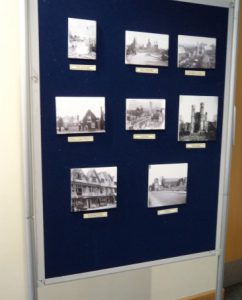
Consequently, even though Canterbury suffered 35 raids and some parts of the city were very badly hit, when you consider just how small the place is topographically, the gigantic size of the cathedral as a target and the closeness to continental Europe, the level of destruction was remarkably limited. As Paul was keen to point out, the loss of any life and people’s homes and businesses is tragic and we were present to commemorate and remember such sacrifices, yet nonetheless Canterbury’s medieval heart was damaged, if not more so, by the actions of post-war planners, developers and local authority officials. The other point Paul wished to make was that the early archaeologists who worked on Canterbury’s bomb sites and other places damaged during the war years, had done an absolutely magnificent job in very difficult circumstances. Indeed, this work had started even before the end of WWII and Audrey Williams’ teams of students and local people had worked tirelessly on excavations such as those in Butchery Lane. Moreover, Paul was concerned to highlight the way these excavations had been conducted because they were done scientifically – the importance of stratigraphy had been recognised, the need to draw and record had been understood and the necessity of careful labelling of finds so that all could be matched as part of the final analysis and write-up.
Paul also discussed the valuable work of the conservation architect Anthony Swaine and Stuart Rigold’s encyclopaedic knowledge of buildings, especially timber-framed structures, as well as the activities of ground-breaking archaeologists such as Sheppard Frere and Frank Jenkins, who, as amateurs, would work during school holidays leading teams of students and locals.
As a consequence of these various excavations across the city, Paul was able to demonstrate how much knowledge was gained regarding both the layout of the city since Roman times, but also considerable detail about individual buildings within this important city. Although he covered far too many sites to discuss here, I’ll just mention Butchery Lane near the heart of Canterbury because not only does it have the Roman Pavement Museum – a shining legacy, but because of the archival, documentary work of William Urry (again in the post-war decades), more recent archaeological excavations have been able to match up for the 12th century individual workshops with their master craftsmen.
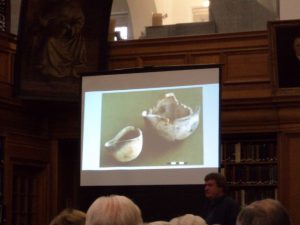
This fascinating summary of Canterbury’s archaeological pioneers was followed by Tim Jones’ films. As he pointed out, during the 1930s there was a very keen band of amateur film makers, some of whom worked in colour. Tim, a Senior Lecturer in Film Studies, has been collecting these films by makers such as Sidney Bligh and John Vissenga and he now adds them to his blog at: https://blogs.canterbury.ac.uk/cafa/ On Saturday he treated the audience to clips from films made in the late 1930s about how to put out fires from incendiary bombs that would have been seen as useful information films at the time, as well as a very rare piece of footage made in 1947 that showed the devastation of the St George’s clock tower area. So ended a fascinating conference and while Andrew Leach, another final year undergraduate who had been helping the organisers all morning, led some members of the audience off towards the Canterbury Christ Church University bookshop and the University’s Touchdown café, those going on Paul Bennett’s afternoon walk headed towards the said clock tower.
Thus at 13.30 the keen group who had booked on Paul’s walk gathered under the St George’s clock tower where he first highlighted the main aspects of Fortress Canterbury which had been in place by 1941. Peter Seary, a member of Canterbury Archaeological Trust, has done a great deal of research on the WWII defences across Kent, and Paul drew on Peter’s work and the work of Andrew Richardson and Keith Parfitt, who have been investigating the early 20th century defences in the Dover and Folkestone areas.
Paul then led his group up St George’s Street to the junction with Rose Lane where he pointed out how M&S was the only survivor of the pre-WWII years before turning to discuss the Longmarket area. In particular, he told his listeners about what had been there before 1942, the post WWII redevelopment following the first archaeological excavations, and then Canterbury Archaeological Trust thorough re-excavation of the site when the area was redeveloped for a second time around 1990.
Moving down Rose Lane towards Whitefriars, Paul drew the group’s attention to the way the street grid had been altered and then changed considerably from what had been there before WWII and then after the raids in 1942. He outlined how the Whitefriars’ precinct boundary had survived the destruction of the friary at the Dissolution and how it had still been in place when the Langton Schools were using the site in the early 20th century. As at the Longmarket, he explained how CAT’s major excavation of the Whitefriars site in the early 1990s had rediscovered important archaeological features but that these had now been swept away forever by the subsequent new development. Then, pausing outside Boots, he pointed out how the developers had wanted some sort of indication of the archaeologists’ presence and that he had persuaded them to illustrate this by making copies of archaeological drawings engraved into the pavement. If you haven’t seen them, do go and look.
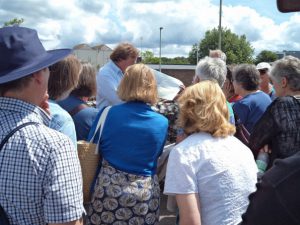
The group then headed towards Ridingate, where Paul pointed out what still survives of this Roman and medieval gate, before heading up on to the city wall. The group stopped at a couple of places as Paul headed towards the Donjon mound and at each he offered information about the city’s WWII defences and what CAT had discovered at excavations in that area. His eager audience were also keen to ask questions and offer their own memories of growing up in post-war Canterbury. Ending his guided walk after 90 minutes, Paul finished with a brief summary of the Trust’s recent archaeological work at the Rhodaus Town site and thus concluded a fascinating day remembering the June Baedeker raid on Canterbury. Thanks are due to all the speakers, but especially to Jordan for his splendid performance and to Paul for not only speaking so passionately in the morning but for keeping up the same tempo in the afternoon.
Finally, for those who would like to know more about this archaeological excavation next to Augustine House, there is an opportunity on Thursday 6 July. As part of the joint programme of lectures organised by the Centre and FCAT, Dr Richard Helm at 7pm that evening in CCCU, Newton, Ng07 will be talking on ‘Roman cemetery to Norman castle: recent excavations at Rhodaus Town, Canterbury’. Do come along if you are interested, and, in the blog next week, I will be able to report on the joint Centre and FCAT lecture taking place this Thursday (same time and venue as Richard’s): Dr Diane Heath’s ‘‘From martyrdom to Magna Carta …’ The life, poetry and fate of Nigel Wireker monk of Canterbury’.
 Centre for Kent History and Heritage
Centre for Kent History and Heritage Sheila Sweetinburgh
Sheila Sweetinburgh 2727
2727